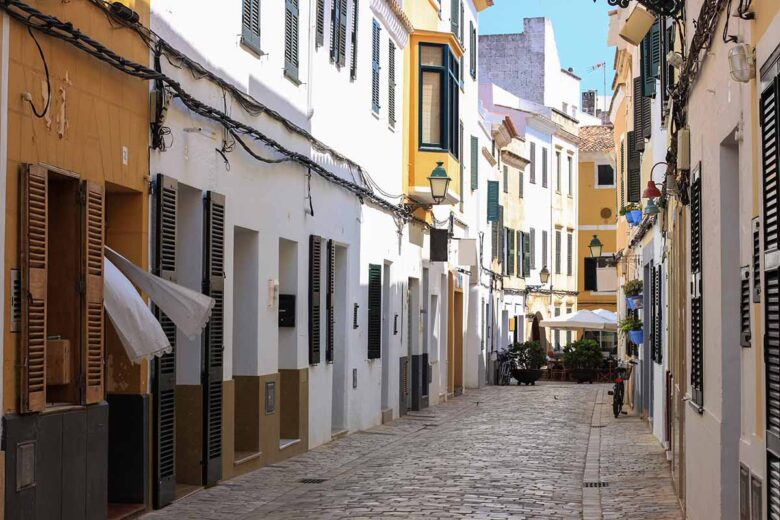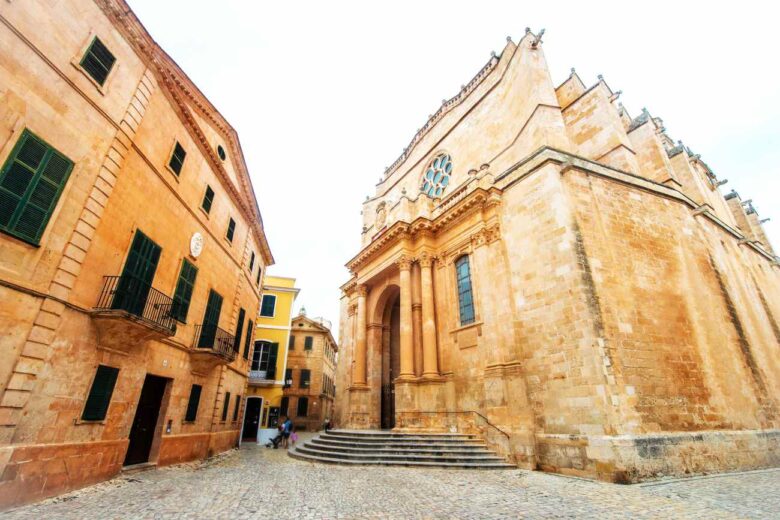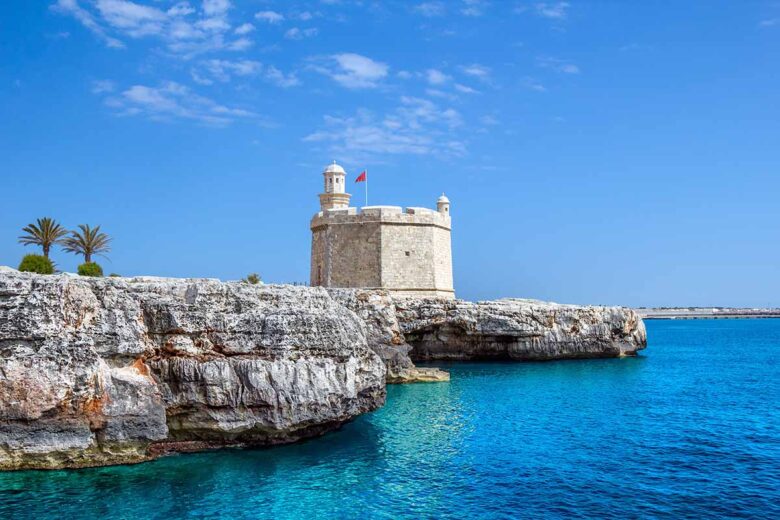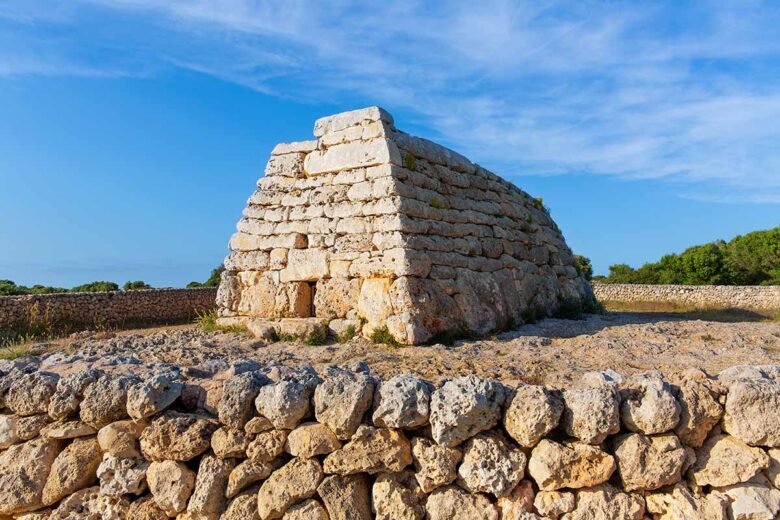
Are you holidaying at one of Menorca’s numerous beach resorts this year? Then why not take a day off from the sand and sea to soak up some of this magical island’s fascinating history and culture. Head over to the west coast, to explore some of the best things to see and do in Ciutadella.
As well as a major tourist destination, the island, and Ciutadella in particular, is a popular short-break destination with those travelling out of season.
Second largest of the Balearic Islands and declared a UNESCO Biosphere Reserve in 1993, Menorca is much more than a sun-soaked isle of over 130 sandy beaches and sparkling azure seas.
Its history dates back to over 4000 BC and contains an extensive collection of prehistoric sites.
The small, medieval fortress city of Ciutadella lies on the island’s west coast, and was, until the early 1700s, Menorca’s capital and centre of commerce.
However, with the arrival of the British in 1708, in 1722, Ciutadella lost this status, when the English declared the city of Mahon to be the island’s capital.
A small, compact city with a picturesque harbour and highly pedestrianised, Ciutadella is ideally suited for those preferring to explore on foot.
With this in mind, I’ve put together this list of 15 of the best things to see in Ciutadella. To give you a head start with your planning.
Read also: Menorca Travel Guide: All You Need to Know
15 Best things to do in Ciutadella
1. Plaza d’es Born – the city’s main square

Located on the cliff top above the idyllic harbour. Plaza d’es Born is the social centre of much of the life of this historic city, and the focal point for many festivals and social events held throughout the year.
A large plaza with manicured beds and a 22-metre-high, 19th century monument to the city’s defenders against the Turkish invasion circa 1558. It is surrounded by grand, tan-coloured buildings and narrow streets that wend their way through the old historic area of the city.
There are a number of interesting buildings around the square, including the old town hall, which is now converted into the local tourist information office.
During the early 18th century, the building was home to the Arab governor, and later the British HQ. You can also climb the battlements for excellent views over the old town area.
Other nearby places of interest include the Theatre des Born, San Francisco Church, the Salort Palace and the Torre Saura Palace.
The square is also home to a general market every Friday and Saturday from 8am to 2.30pm.
For those who enjoy a before or after-dinner stroll on those balmy summer evenings, the square holds a smaller evening artisan craft market on weekends selling arts, crafts, bric-a-brac, souvenirs and mementoes.
2. Relax, and stroll the historic old town area of Ciutadella

In almost any direction you head from the main square, you’ll be entering the old town area of Ciutadella. Narrow streets are hemmed in by tall tan-coloured homes, local businesses, shops, cafes and eateries. All dappled by the rays of the warm Mediterranean sun.
You’re not going anywhere, so go where you like, soaking up the atmosphere of how things used to be.
One street to look out for is Ses Voltes (The Arches), lined with arches holding local shops, ice cream parlours, bakeries, bars and restaurants. It’s a great stop-off point for a light lunch and a little people-watching.
One word of caution, the Spanish siesta is still a big part of Menorcan culture. Unless operating in the major tourist areas, many local businesses and shops shut from 2.00pm until 5.00pm, reopening until seven or eight in the cooler evening period.
If walking plays a big part in your normal holiday itinerary, you can also do a longer walk, which follows the route of the old city walls that protected the area up to the 19th century.
3. The Cathedral of Menorca – (Catedral de Santa Maria de Ciutadella)

Right in the centre of the old town, the impressive Cathedral of Menorca is built on the site of an old Muslim mosque and incorporates the mosque’s minaret in its bell tower design. It was built in the 14th century by King Alfonso 3rd to commemorate the Virgin Saint Mary.
With a single chamber and eight chapels, the church has a number of stunning stained-glass windows around the altar area, and is considered the island’s most well-preserved piece of Gothic architecture.
The cathedral became the bishop’s residence in the 18th century when the diocese of Minorca was formed.
Badly damaged during the 1936/39 Spanish Civil War, the church was refurbished in the 1980s, and its organ was added in 1993.
The cathedral holds regular classical music concerts open to the public, and houses a small museum where you can view numerous religious and cultural relics and artefacts.
Although anyone can take part in either a Spanish or Catalan service depending on the time of day, access to general visitors is from 10.00am to 2.30pm.
4. The Bishops Palace Courtyard
Easily missed if you didn’t know it was there. As you leave the cathedral, the guides will generally point you toward the big wooden door numbered 8. It is the entrance to the courtyard of the Bishop’s Palace.
Although the palace itself is not open to the public, you can freely look around the courtyard.
It is a typical Spanish Mediterranean garden of hard landscaping with a pretty stone well in the centre, and a stone stairway leading to a locked first-floor door.
To break up the harshness of the stone, raised borders hold mature trees and hedges, while pots of flowering plants add a little colour.
Not a lot to see, but if quiet, a lovely place to sit and contemplate for five minutes.
5. Convent and Cloister of Saint Augustine
The convent, cloister and cathedral are located next to each other, and if religious architecture and history are your passion, a joint ticket can be purchased to enter both buildings.
The Augustine convent with its whitewashed arches dates from the 1600s, and is attached to the Socors Church.
Its cloisters are arguably the focal point, with its ten rooms dedicated to various museum artefacts from the Menorcan Diocese and archaeological finds from the Talayotic era.
Other rooms cover diverse areas of Natural History, including paleontology and malacology. You will also find old maps, curios and numerous small figurines from the Roman era.
The small, pretty garden where nuns used to sit and meditate, the ground floor rooms and the church can be visited anytime. The upper floors can only be visited on a guided tour which starts every day at midday.
6. Take more than a passing glance at Palacio Salort
Palacio Salort sits on the edge of the main square and is one of two palaces (the other one is Torre-Saura Palace) you will find on the square. It dates back to 1813, and has a novel entrance to the main chambers.
The ground floor has been leased for commercial use, and you need to stroll through the lobby and the popular Moriarty Tapas Bar on your way to the main entrance.
An impressive balustrade-lined stairway leads to a wide, airy landing with the main rooms leading off.
The Red Room is a gallery of portraits of the present owner’s family, including the current patriarch Don Carlos de Salort y Olives, dressed for the feast of St John the Baptist, patron saint of Ciutadella.
You can inspect the sizeable tiled kitchen laid with bowls and cutlery in preparation for the servants evening meal.
The palace also houses several French tapestries, English-period furniture, and 19th-century ceiling paintings.
Take a look round the old courtyard. If the garage doors are open, you might catch a glimpse of a 1920s motor vehicle, one of the first cars to arrive on the island.
7. Casa Olivar – Olive Grove House, affluent living in Menorca
If you’re interested in seeing how the affluent in Menorca lived back in the 1600s, pay the small entrance fee and take a stroll around Casa Olivar.
Still in the main square, opposite the cathedral, Casa Olivar was built in the 15th century and extended and embellished in the 16th and 18th centuries by the Olivar family. It is owned and managed by them to this day.
Considered one of the most impressive buildings on the island, the mansion is full of priceless antiques, frescoes, tapestries, chandeliers and furniture, giving a great insight into the aristocratic lifestyle of the 16th century.
You also get a chance to look around a 16th-century tack room. During the Festival of Saint Joan (St John the Baptist), costumed noblemen rode through the streets of Ciutadella on glossy black horses, decked out with caparison of family coats of arms and motifs.
The tack room includes all the horse tack used, the rider’s costume, and photographs from previous fiestas.
You can also visit the small yard, stables and store rooms where an old water storage cistern is still in place. Information boards dotted around the premises are in English.
8. Visit a local market at The Mercat de Peix Fish Market
When looking for things to do in Ciutadella, there’s nowhere better than a local market to get an up-close impression of the resident population’s day-to-day living habits.
Located near the cathedral, on the Placa de la Llibertat, the Fish Market of Ciutadella is relatively new as markets go, and is the only remaining example of 19th-century cast-iron architecture in Menorca.
The market has an arched façade with green and white tiled pillars and an interior of wrought iron and further tiling.
What makes the market so popular with local residents, hoteliers and visitors looking for things to see in Ciutadella, is there is as much going on outside as inside.
Inside, you will find locals bartering with fish mongers as they strip and gut the fresh catches and prepare shellfish.
Outside butchers prepare different cuts of beef, lamb, chicken, rabbit and other meats. Fruit, veg, peppers and spice stalls can be found, as well as cured meats, hams and local cheese vendors.
Add to that the several tapas bars and restaurants close by, and the area is a haven for both local and visiting gastronomes.
The Mercat de Peix Fish Market is open from 7am to 1pm Tuesday through Saturday.
9. The Port of Ciutadella – for lazy days and unforgettable evenings

The one-kilometre-long narrow port of Ciutadella is split into three sections. Its commercial freight section, its fishing and ferry port and its attractive, wealthy marina.
With freighters loading and unloading their cargoes, ferries coming and going to places like Majorca and Barcelona, the fishing fleet unloading their catches, and private pleasure craft coming and going, it is a busy, vibrant port whenever you choose to visit.
From the top end of the harbour by the slipway, you can choose to walk either side of the port on the wide quaysides.
What, back in the day, were boat houses, fishermen’s tackle sheds, and chandlery stores carved out of the cliff face, are now seafood restaurants, chic cafes, craft and souvenir shops and in-vogue tapas bars.
The port is one of Ciutadella’s most visited attractions.
During the day, you can stroll the long promenades, taking in the atmosphere of daily port life. Do a little holiday shopping and stop for a lite-bite while you plan your afternoon itinerary.
Ciutadella port is also the main district for evening entertainment. Of course, Mallorca or Ibiza it’s not, but for most couples and families, it is an excellent venue for some night time entertainment.
Restaurants are excellent, many serving late into the evening, while traditional and international bars are open until one or two in the morning.
With the port lit up and the lights reflecting off the water, it provides an excellent setting for an intimate family meal or romantic special occasion dinner for two.
10. Enjoy a Boat Trip from the Port of Ciutadella
If you’re booking a full holiday or short break stay in Menorca, consider adding a half-day boat trip to your things to do in Ciutadella.
Trips are various and take in visits to a number of the picturesque small beaches and coves unreachable by road.
Other trips include a ferry service to Mallorca, Barcelona and other island destinations. Most half or full-day trips include a paella lunch.
Other water sport activities are available around the port including organised kayak trips around the headland, or snorkeling and diving trips to explore the cliff bases and submerged caves.
Recommended tour: Natural Coves and Beaches Boat Trip & Paella Lunch
11. Castell de Sant Nicolau – prime port defences

During your visit to the port, when you reach the end of the promenade, keep walking towards the harbour mouth.
Within a short time, the Castell de Sant Nicolau will begin to appear, sitting on the headland near the harbour entrance. Baroque-style sculptures can be seen adorning the entrance to the fortress.
Built by the Spanish in the 17th century at Paseo Marítimo, its job was to defend the port from marauding pirates and Ottoman raiders.
Octagonal in shape, and constructed using thick blocks of Menorcan stone, the fortress had a moat, drawbridge, and turrets and was equipped with cannons and muskets.
The fortress also housed a platoon of soldiers, animals, and food rations. The Castell de Sant Nicolau is one of two fortress towers on the Ciutadella coast, the other being at Sa Caleta.
Nearby is a statue of Admiral James Farragut, whose father and mother emigrated to the US from Menorca before he was born. Born in 1801, he joined the American Navy at age ten and went on to be the US Navy’s first admiral.
The fortress is a popular attraction to see in Ciutadella, but only opens for self-guided tours through the main tourist season of May through September.
12. The Municipal Museum of Ciutadella
The museum was originally opened in 1935, in the 17th century Sa Font Bastion sitting on the cliffs above the port.
It is a museum dedicated to Menorca and its people from the pre-Talayotic times, right through to the arrival of the Moors.
The permanent exhibition organised by the local council includes an impressive number of ethnological items, and a significant collection of archaeological finds and jewellery.
Many of them discovered in the caves of Cova des Mussol and Cova des Càrritx.
With the collection growing through the years, in 2018 it was decided to move the museum. A year later it relocated to Can Saura, Carrer del Santíssim 2. Another old 17th-century townhouse owned by the council.
The exhibition initially took up the ground floor, but in 2020 space was expanded to include the first floor.
The display also includes a section on the different beliefs and death rituals of Menorcan peoples, going back as far as the cave dwellers.
You will also see an ancient Moorish cemetery, discovered beneath Can Saura when it was being converted into the museum.
The museum also runs extensive workshops and educational programmes for school children and college students.
Opening times and additional information can be found at: www.ajciutadella.org
13. Ciutadella’s Art Galleries – places to view the work of local artists
Not as well publicised as the larger attractions around the city, Ciutadella has a busy, active artistic community whose work is often sadly overlooked.
However, if painting and sculpting artists in different genres are your interest, several galleries are open to the public, some with a small entrance fee and some free to visit.
One such gallery is the Pedrin Art Gallery at Carrer Seminari 30, Ciutadella.
Pedro Rodríguez Pedrin was born in Malaga and is a leading sculptor using materials such as clays, ceramics, iron, bronze and marble. His unique style ensures that once you have had a chance to view his work, you will recognise it wherever you find it.
Other galleries of interest to see in Ciutadella include:
- Galeria d’Art Retxa ; A permanent exhibition of Menorcan and Spanish artists.
- Art i Joc Gallery; A permanent exhibition of Menorcan and Spanish artists
- Vidrart; A permanent exhibition of Menorcan and Spanish artists, photographers and sculptures as well as special events
14. Take in a sunset at Pont d’en Gil

There’s something magical, romantic, and mysterious about a sunset. And when we’re on our holidays we’re invariably looking for somewhere to get the best sun-setting shots for the family album. Even if we don’t realise we’re doing it.
When compiling your list of things you want to do in Ciutadella, jot down at least one visit to Pont d’en Gil for a super sunset.
Pont d’en Gil is a natural bridge over an arch hewn by the actions of the Mediterranean Sea beneath a clifftop promontory.
Located a little further around the coast from the mouth of Ciutadella port, the Gil is a short car ride (10 minutes), with plenty of parking available.
For those hardy folk, the walk takes around 40 minutes. The attraction is very popular with visitors and locals. Many arrive early with sandwiches and drinks to secure their considered best place for that one-time sunset shot.
Or just to sit, and enjoy the end of another summer’s day.
15. Naveta des Tudons – burial site from the Talayotic era 900 BC

If you have a love of archaeology and ancient burial sites, you might want to put a visit to Naveta des Tudons on your things to do in Ciutadella list.
Dating to over 1000 BC, the site sits at Carretera Maó – Ciutadella, and is a 10-minute drive or taxi ride from the city.
A 1960s excavation of the site unearthed the remains of hundreds of men, women and children of the Talayotic era, plus numerous personal items that were buried with them.
The tomb is built of Menorcan stone slabs and constructed dry-wall style without any form of adhesives or sealants.
The artefacts included bone buttons, bronze bracelets and weapons, pots and vases, some of which are now on show in the local museum.
Images: Shutterstock